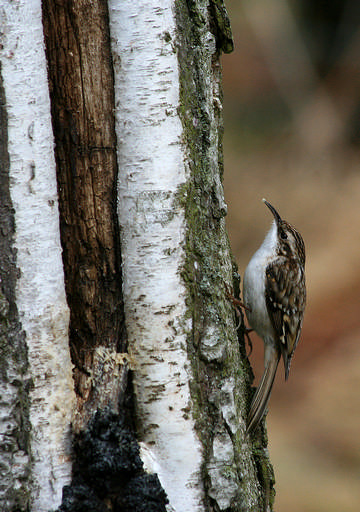
Treecreeper © Sheila Bamire
Although probably less obvious in winter, when they do not sing and seldom call, and thought to be under-recorded in winter (BTO Winter Atlas), Treecreepers were nevertheless found in 54 more tetrads than in the breeding season. The species is scattered widely across the county; areas occupied in winter only include a noticeable cluster in the lower Gowy valley (SJ46 & SJ47) and around Macclesfield (SJ97). Adult Treecreepers are thought to maintain their breeding territories all year round; these territories vary in size from 1 to 15 ha, a large area for a small passerine but only equivalent to a circle 440 m in diameter, and adults almost never move more than 500 metres (Migration Atlas). This, and their reluctance to cross open areas (BWP), vitiate the species’ colonisation of new areas. The birds found in winter but not in the breeding season are likely to be first-year birds dispersing from their parents’ territory. Examination of the winter habitat codes submitted show almost identical numbers in woodland (369 breeding season, 354 winter), but large increases in the figures for farmland hedgerows (from 23 to 63) and human sites (from 30 to 87), showing those birds spreading out from the core woodland areas into a wider range of habitats.
In winter, Treecreepers continue to search trees for insects and spiders, their long bill allowing them to probe where no other bird can, but also eat seeds, especially of pines and spruces. Within the last decade Treecreepers have started feeding on peanuts in hanging baskets at a number of sites scattered widely across Britain, in Devon, Buckinghamshire, Carmarthen and several Scottish counties, although this habit seems not yet to have been noted in Cheshire and it would be interesting to document its uptake. They sometimes associate with tit flocks, but usually feed solitarily, not often even with others of its own species. Out of the 724 records of Treecreeper submitted over the three winters, 328 included counts: 240 of them were of a single bird, with 70 records of two together, 12 records of 3 birds and six counts of four birds.
A fascinating aspect of Treecreeper behaviour is their occasional use of roosting holes which they excavate themselves in soft wood, including dead alder and, famously, redwood (Wellingtonia) Sequoiadendron giganteum trees. They usually make their roost-holes on the north-east side of the tree, away from the prevailing wind, a wise precaution since winter rainfall has been shown adversely to affect their survival (Peach et al 1995b). Such roosts have not been observed in Cheshire and Wirral – indeed during this survey there were no reports at all of roosting Treecreepers – but it would be an interesting little study to visit some of the county’s few redwoods to see if Treecreepers here have learned this habit.
Sponsored by Tony Coatsworth and Gina Jones

